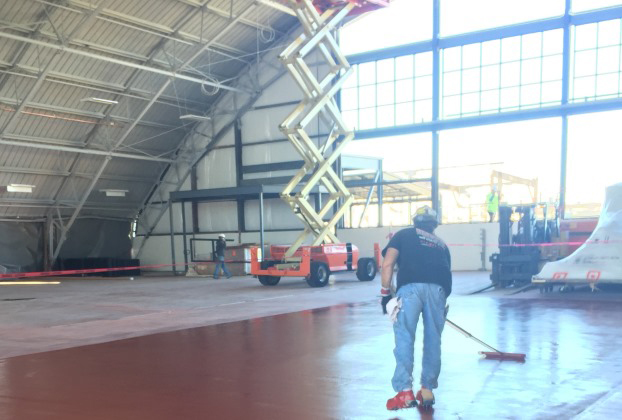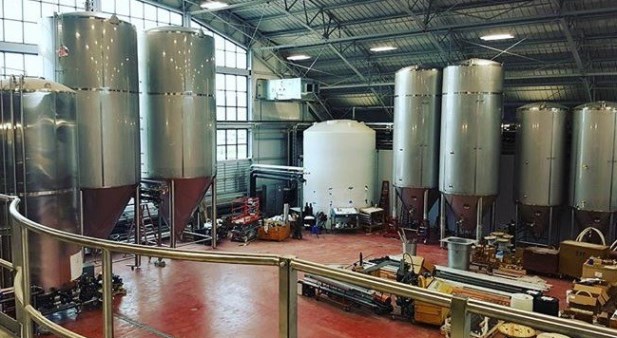MadTree Brewing Co. made history upon opening in 2013 by becoming the first modern craft brewery to can its beer in Ohio. But with demand surging after four years of operations, they knew by late 2016 that they needed more space.
The brewer wanted its new site to launch in tandem with an annual anniversary party, held each February. Unfortunately, construction conditions at that time in the upper Midwest are difficult, especially for flooring contractors dependent upon mild weather for curing.
Nonetheless, one crew at Hardig Industrial Services embraced the challenge.
“Being in Cincinnati, we do end up with crazy weather,” said Kevin Kipp, Hardig estimator and project manager. “It slowed things down, but overall, we had a plan to prevail.”
Brewing Up a Plan
In addition to frigid conditions, the sheer magnitude of the expansion posed its own challenges. The $22-million project involved “new construction conditions” of converting a 50,000-square-foot (4,645.2 m2) shuttered paper mill into a brewery.
“The entire floor had to be poured with a new, 12-in [30.5 cm] concrete slab,” Kipp said.
Whereas MadTree’s former site had a taproom capable of hosting 80 patrons, capacity at the new taproom was slated to accommodate 500. A warehouse area with office space and a separate room for the actual brewery also had to be built. “It’s a very high-end brewery with state-of-the art equipment,” Kipp said. “They wanted to have a glossy, good-looking floor.”
Because of the enormity of the job, more than 60 contractors — many representing other trades — were at the site daily, all on a tight deadline. As a result, planning for both cold temperatures and making accommodations for other trades was quite an undertaking.
“There were steel erectors, masons building, electricians hanging lights, painters, and much more. Every trade that could potentially be in on the process side was in at the same time,” Kipp recalled. “When you’re the flooring contractor, you take up a lot of space that’s very valuable for a few days. You don’t make friends very easily that way. But we had on-site project management that maintained a good balance with the other contractors,” he continued.
To keep that balance, Hardig’s 8- to 10-person crew worked in individual sections from start to finish to allow other trades to get to work more quickly. Kipp said the process slowed production slightly and required extra integrity checks. But in the end, all trades understood that collaboration was necessary.
“It took a lot of negotiating with other trades and finding a common ground,” Kipp said.
Hop to It!
With the timing mapped out, Kipp’s crew quickly went to work. They divided the job, slated to last 6 to 8 weeks, into three sections: the brewery, the taproom and warehouse, and the restrooms and bars.
The coatings crew began each day by putting on standard personal protective equipment (PPE), including 3M disposable respirators, safety glasses, hard hats, and steel-toed, spiked shoes from Seymour Midwest.

The brewery production area was first on the list. The 16,000-square-foot (1,486.5 m2) area was shot blasted with a Blastrac 10-D machine to the International Concrete Repair Institute’s (ICRI) Concrete Surface Profile (CSP) 4-6, and joints were filled. From there, the team applied a Flowfresh SR concrete urethane floor system from Flowcrete, in part based on a successful case study of its installation at Florida Beer Company.
“One of the owners called the Florida brewery and got a reference for their flooring to ensure they were happy with the results and performance,” Kipp said.
The Flowfresh SR system was installed for MadTree at ¼ inch (0.6 cm), and a topcoat of the Flowseal 985 polyaspartic floor coating was applied via 18-inch (45.7 cm) squeegees at 10‒15 mils (254.0‒381.0 microns) of dry film thickness (DFT) and backrolled.
“The polyaspartic was a good choice because it can handle the hot temperatures required in a brewery, and it offers more abrasion and UV [ultraviolet] resistance with a more aesthetically appealing finish,” Kipp said.
The brewery production floor was fully installed over two weeks in late November, but the crew also had a bit of good fortune.
“We had [unseasonably] great weather,” Kipp recalled. “The steel erectors hadn’t had the building closed in yet, so we didn’t have conditional space. We had to work with open elements, and we lucked out. The two weeks we installed, the weather was cooperating. That was a big part of why we were there when we were.”
The crew wasn’t as lucky with the remaining two phases — namely, the tap room/warehouse and the restrooms and bars. With February 11 set as the grand opening, the tap room had to be completed in December and January, and that meant working through several single-digit temperature days in an unconditioned space. Large propane and salamander-style heaters were used to get the temperatures needed to conduct the work, Kipp said.
The taproom is always a brewer’s most visible room, and it was also the most challenging because of a mix of concrete conditions. As a result, surface preparation was a longer and more diverse process. Steps included jack hammering, scarifying, and diamond grinding with Lavina’s 30G-X propane grinders, while the SikaQuick 1000 and MAPEI Quickpatch materials were used for patching. The floor was then clear coated for a dust-proof, industrial clear look with two 3- to 4-mil (76.2‒101.6 microns) coats of the General Polymers 3477, an epoxy water emulsion primer and sealer.
The restrooms and bar areas were the finishing touches. The surfaces were prepared by diamond grinding with Lavina’s propane grinders, and an initial 6- to 8-mil (152.4‒203.2 microns) coat of the General Polymers 3569 was applied as the primer. Then, two 10- to 12-mil (254.0‒304.8 microns) coats of the General Polymers 3744, a high-performance epoxy, were applied in charcoal to give those areas a different “feel” from the taproom and brewery, according to Kipp.
Eight weeks after starting the project in late November, the Hardig team toasted to a job effectively complete!
Cheers to Teamwork
Despite frigid weather and the multitude of trades, MadTree finalized its permitting and inspection processes in late January and hosted its grand opening in February, as planned. While the initial opening consisted of just the taproom, full brewing operations also moved to the new site later in the spring.
“The feedback has been very good,” Kipp said. “The floor has been in for months, and literally every construction process happened over the top of it,” he continued. “That’s everything from tank and fabrication, pipe fitters, electricians, welding, and more. The floor has some minor damage, but overall, it is in amazing condition for what it’s seen.”
Teamwork and patience paid off for both the client and crew, and all sides can now celebrate with a fresh batch of craft beer. Cheers!
